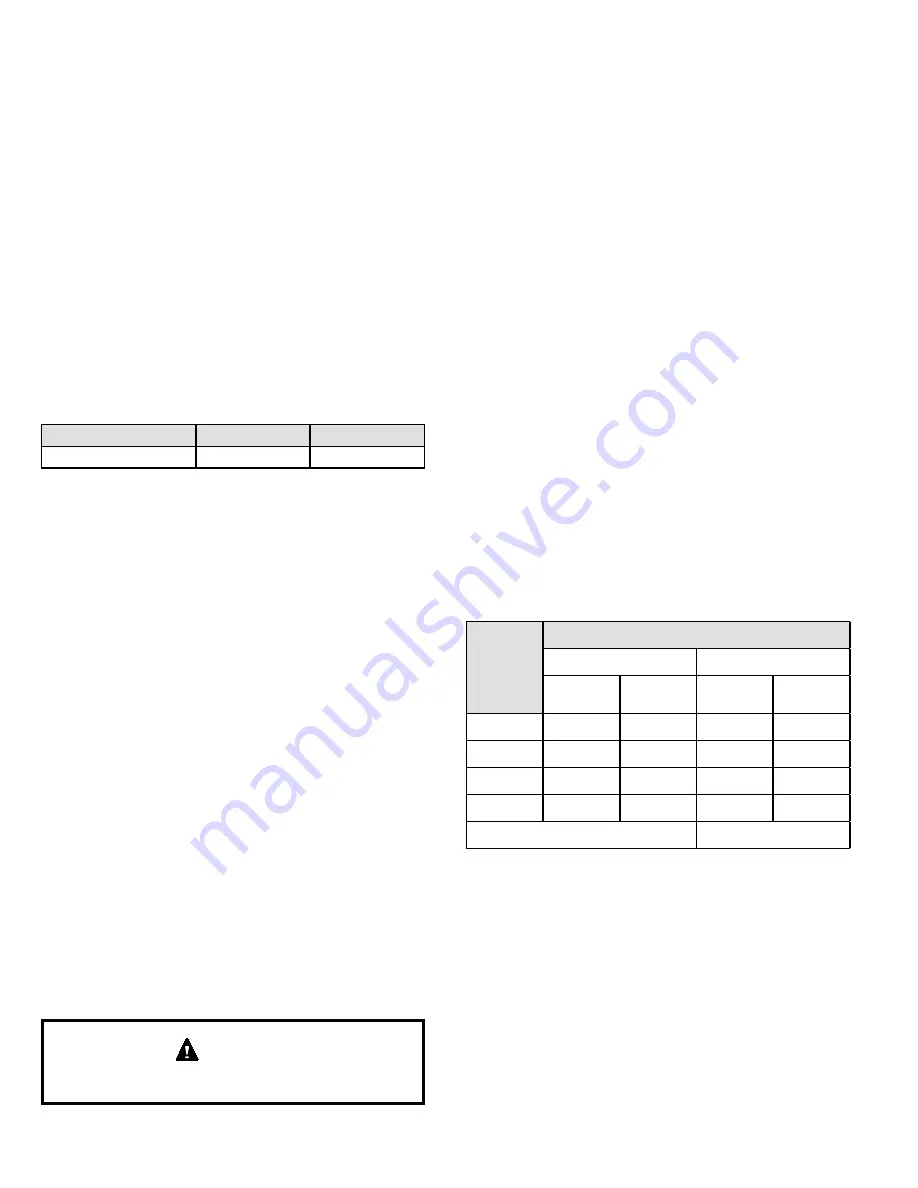
508146-01
Issue 2051
Page 5
2
of 7
0
When checking piping connections for gas leaks, use
preferred means. Kitchen detergents can cause harmful
corrosion on various metals used in gas piping. Use of a
specialty Gas Leak Detector is strongly recommended.
Do not use matches, candles, flame or any other
source of ignition to check for gas leaks.
Testing Gas Supply Pressure
When testing supply gas pressure, connect test gauge
to supply pressure tap on the gas valve. See Figure 47.
Check gas line pressure with unit firing at maximum rate.
Low pressure may result in erratic operation or underfire.
High pressure can result in permanent damage to gas
valve or overfire. See Table 25 for operating pressure at
unit gas connection (line).
On multiple unit installations, each unit should be checked
separately, with and without units operating. Supply
pressure must fall within range listed in Table 25.
All Units
Natural
LP
Line Pressure w.c.”
4.5 - 10.5
11.0 - 13.0
Table 25.
Check Manifold Pressure (Figure 49)
To correctly measure manifold pressure, the differential
pressure between the positive gas manifold and the
negative burner box must be considered. Use
pressure test adapter kit (available as
Comfort-Aire/
Century
part 10L34) to assist in measurement.
1.
Remove the threaded plug from the outlet side of the
gas valve and install a field-provided barbed fitting.
Connect measuring device “+” connection to barbed
fitting to measure manifold pressure.
2.
Tee into the gas valve regulator vent hose and connect
test gauge “-” connection.
3.
Start unit on low heat (40% rate) and allow 5 minutes
for unit to reach steady state.
4.
While waiting for the unit to stabilize, notice the flame.
Flame should be stable and should not lift from burner.
Natural gas should burn blue.
5.
After allowing unit to run for 5 minutes, record manifold
pressure and compare to value given in Table 29.
6.
Repeat steps 3, 4 and 5 on high fire.
7.
Shut unit off and remove manometer as soon as an
accurate reading has been obtained. Take care to
remove barbed fitting and replace threaded plug.
8.
Start unit and perform leak check. Seal leaks if found.
Do not attempt to make adjustments to the gas valve.
CAUTION
Operating Pressure Signal (Delta P)
Operating pressure signal can be taken while the
manifold pressure pressure check is taken (using two
measuring devices). Or, taken after the manifold pressure
measurement is complete.
1.
Tee into the negative line between the gas valve and
pressure switch and connect to measuring device
negative “-”.
2.
Tee into the positive line between the gas valve and
pressure switch and connect to measuring device
positive “+”.
3.
Start unit on low heat (35% rate) and allow 5 minutes
for unit to reach steady state.
4.
After allowing unit to stabilize for 5 minutes, record
operating pressure signal and compare to value given
5.
Repeat steps 3 on 4 high heat.
Proper Gas Flow (Approximate)
Furnace should operate at least 5 minutes before checking
gas flow. Determine time in seconds for two revolutions of
gas through the meter. (Two revolutions assures a more
accurate time.) Divide by two and compare to time in Table
26. If manifold pressure matches Table 29 and rate is
incorrect, check gas orifices for proper size and restriction.
NOTE:
To obtain accurate reading, shut off all other gas
appliances connected to meter.
Model
Seconds for One Revolution
Natural
LP
1 cu ft
Dial
2 cu ft
Dial
1 cu ft
Dial
2 cu ft
Dial
-070
55
110
136
272
-090
41
82
102
204
-110
33
66
82
164
-135
27
54
68
136
Natural - 1000 btu/cu ft
LP - 2500 btu/cu ft
Table 26. Gas Meter Clocking Chart














































